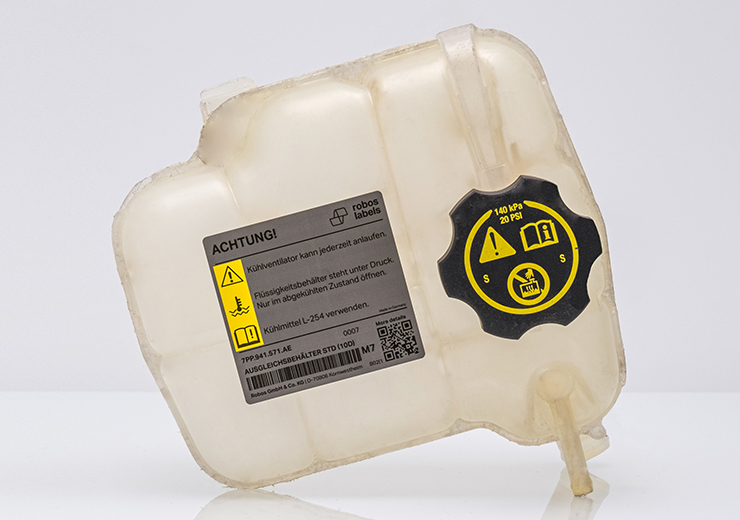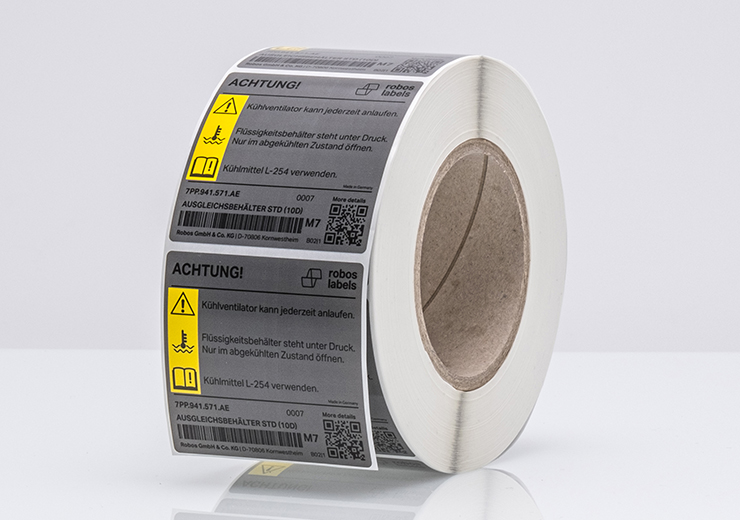Labels for automotive: consumer information for the vehicle exterior and the engine compartment
These labels will be adjusted very individually to the high requirements and quality standards of the automotive sector. They must outlast the whole life circle of a vehicle and provide important information for different target groups. Here the labels with assembly-, warning- and use information, and application manuals will be applied. The materials and the executions are tailored exactly to the later application purpose. Here the OEM (Original Equipment Manufacturer) mostly differentiate between interior, exterior and engine compartments, whereby different requirements like e.g. UV resistance, permanent legibility or safe adherence are paramount.
The key features of automotive labels for the vehicle exterior application
- High abrasion resistance with suitable thermal transfer ribbons for the thermal transfer printing
- Temperature and UV resistance
- Resistance against humidity and frost
- Resistant against chemicals in cleaning liquids
- Suitable for the labeling in accordance with standards like e.g. UL/CSA, ATEX, FMVSS etc.
- Very high adhesive power also on difficult substrates
- Optimization of processes due to the automation of material and product flow
- Additional safety functions like e.g. security cut-outs possible
- Over 500 special materials by Avery, 3M, Flexcon, and Tesa available from stock
- Labels and identification in individual formats and special forms
Functions and advantages – precisely tailored to your requirements for the labeling
The labels for the engine compartment or for the application on vehicle exterior offer the best possible flexibility and will be adjusted individually to the customer’s requirements. This happens by using suitable special materials of leading manufacturers, individual die-cutting forms and premium adhesives.
The labels can be inscribed directly as required in variable amounts with current data at the site, by that the storage and the management of numerous labels may be dropped.
Our upscale and accurate processing with most modern die-cutting technologies guarantees the highest precision and reliability for the label application. Thus even labels with adhesives which are difficult to process can be processed mechanically very well, which increases the user efficiency in the long term.
Frequently Asked Questions
Applications of labels on the vehicle exterior or in the engine compartment
The typical labeling products and their functions:
- Tire pressure labels
- Paint protection labels
- Traceability, batch numbers
- Labeling in tank caps or engine compartment
- Gearbox, axle and breaking system labeling
- Information on the liquid containers and batteries
- Labels for documentation of installation, repair and service
- Product identification in the engine compartment on parts, cables and tubes
- Warning and consumer information regarding heat and chemical resistance
- Safety information and instructions for use of engine parts and vehicle data
Individual features of automotive labels for engine compartment and the vehicle exterior
Especially in the engine compartment, on the underbody or a tank cap the labeling products are exposed to harsh conditions. Additionally, there are substrates to be labeled which are partially high-energetic, but also partially very hard to adhere to. This includes porous, abrasive, small and round or slightly oily surfaces, cast iron, powder or hammer paint coatings.
Our material combinations fulfill all requirements of the supply chain processes and all common regulations and test parameters of the automotive industry and OEM. Here especially the adhesive power of the labels in regard to progressing aging grades, an excellent resistance to chemicals as well as the resistance of the imprints against the mechanical load are paramount.
Each OEM has its own standards in regard to the testing methods to examine the aging, the adhesive power, the resistance to chemicals as well as mechanical resistance. In regard to the material wear our labels must often pass the tests with extreme heat, cold, humidity and changing cycles on the customer’s original substrate. The adhesive power will be mostly examined with the current Finat testing methods. Additionally, there are smearing-, submerging-, and dripping tests with defined chemicals as well as mechanical abrasion tests within the scope of the respective predefined and customized parameters. Conclusively also tests for material flammability, salt spray test or a test with steam jet cleaners can be required.
Moreover, we have an IMDS ID number and list our materials in IMDS (International Material Data System), an international and browser-based data base of the automotive industry, where the information about the composition of our labels and the banned substances list can be retrieved.
Technical key data of our labels for engine compartment of a vehicle
- Temperature resistance from +300°C (572°F) to -85°C(-121°F)
- UV and weather resistant foils up to max. 15 years
- Very thin (min. 6µ) as well as very thick (175µ) combinations of foils possible
- High-performance materials made of polyvinylchloride-foil (PVC), acrylate-foil, polyimide foil, aluminum foil and polyester (PET)
- Permanent, repositionable and removable adhesives with a very good adhesive power for high-, middle- and low-energy substrates
- Diverse carrier materials like compressed kraft paper in different thicknesses, transparent plastic liner, kraft paper siliconized on both sides, and environmentally stable kraft paper available
- Subsequently inscribable with thermal transfer printing, laser engraving and ink jet method
- Foil features are from soft and smooth and stretchy to stable and tear-proof
Certifications of our automotive labels
As a manufacturer robos-labels has a wide range of already approved and certified labeling solutions. When additional customized licenses are required, we can take on the approval- and certification process if desired.
We also cover the first article inspections (PPF, production process and product release) in accordance with the specifications of German Association of the Automotive Industry (VDA) as well as the American counterpart, a PPAP inspection (Production Part Approval Process) of the AIAG (Automotive Industry Action Group).
We already meet the following standards and regulations with our raw materials:
- FORD WSS-M99P41-A72
- MS-13445 (FCA – Fiat Chrysler Automobiles)
- TL 52038 (Volkswagen standard)
- GMW14573 (General Motors)
- TM-0030T-Y (Tesla)
- GS 97058 (BMW)
- MS 373-12 (Hyundai)
- DBL 8230 (Mercedes-Benz)
- TSM7508G (Toyota)
- UL969 Marking and labeling systems (labels on smooth and not convex surfaces)
- UL817 Safety cord sets and power supply cords
- UL2238 Cable assemblies and fittings for industrial control and signal distribution
- UL94 Flammability of plastic materials for parts in devices and appliances (UL VTM-0 strictest classification)
- FMVSS 302 Evaluation of the flammability of interior materials (flammability/burn rate)
- REACH, RoHS and IMDS conformity
- ADR 2021 Ordinance on the transport of dangerous goods by road, rail and inland waterways (GGVSEB)
- CLP Regulation (Classification, Labelling and Packaging, in accordance with EC No. 1272/2008)
- BS 5609 Label resistance to saline sea water
- DIN EN ISO 11683:1997-11 Packaging – Tactile warnings of danger – Requirements
- FDA 175.105 INDIRECT FOOD ADDITIVES: ADHESIVES AND COMPONENTS OF COATINGS

